Oct 31, 2018 | wedding planning
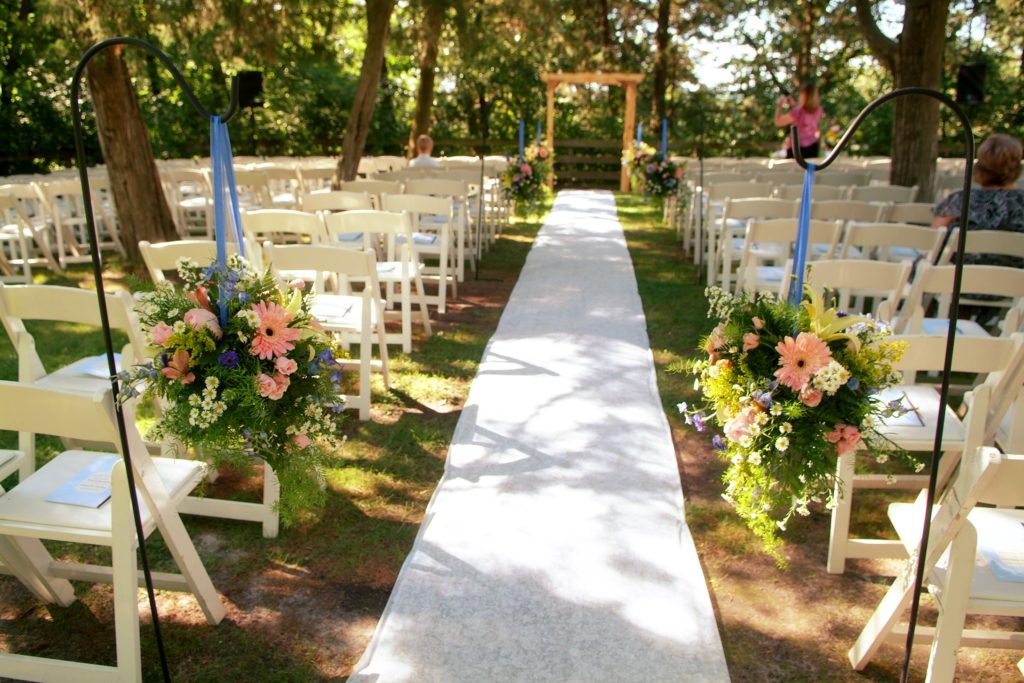
Here’s one location where an aisle runner might actually perform its intended function. Photo by Magical Moments Photography.
There’s one bit of wedding tradition that I usually recommend against, and that is the use of aisle runners. They are, fortunately, not as popular now as they were a few years ago, and I’m glad to see them go.
And what is so bad about them, you might ask? I find them to be terribly wasteful. The inexpensive ones that a florist typically supplies or that can be bought online are made from a non-woven synthetic fabric, such as polyester or polypropylene (both petroleum products). Needless to say, these runners anything but biodegradable. And they are a one-use item. After the wedding ceremony, the aisle runner will be thrown out. (I’ve personally thrown out more than one in my career.)
According to my colleague Lynn Fosbender of Pollen Floral Design, an aisle runner used to be a necessary item at a wedding before paved roads were found everywhere. The runner would be drawn down the aisle after the guests were seated to cover all the road dust so it wouldn’t soil the bride’s white gown. With that in mind, the only time a runner might still be useful would be at an outdoor wedding in a location where the aisle was bare dirt or rock.
If you find that a runner is necessary, or highly desirable, there are a few options for eco-friendly aisle runners. One possibility is to purchase a runner made from biodegradable materials, such as burlap, cotton canvas, or cotton duck. These tend to be more expensive than the disposable runners. Another option might be to find someone to make one for you out of a heavy, biodegradable material. This would definitely be more expensive!
Even if you can find (and afford) an aisle runner made from natural materials, the next question is what will become of it after the wedding ceremony. If you can re-sell it to someone who can use it, that would be one eco-friendly choice. Another possibility would be to re-purpose the fabric, if it is clean enough to use. (You could make a lot of throw pillows out of 75 feet of cotton duck!)
But it seems to me that there are very limited options in this realm of wedding paraphernalia. It isn’t easy to find an eco-friendly runner in the first place, and there are few things to do with it afterwards. All that is why I say, “Skip the aisle runner.” It’s a choice that is easy on your budget–and no one will miss it.
Oct 22, 2018 | Budget Planning
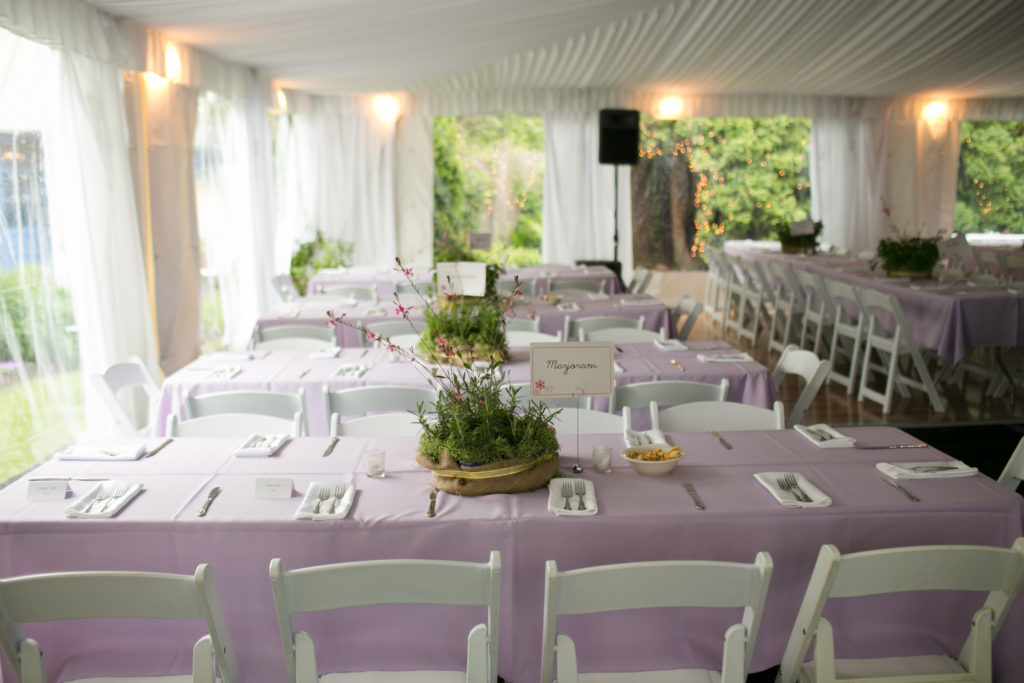
Your backyard tented wedding reception can be elegant and beautiful, if it is properly planned. Photo by Christy Tyler Photography.
I have done a lot of backyard weddings in my career. There is a lot to be said for them. There are also some cautions to keep in mind. Here is what I know.
If you or your parents or someone else you know has a suitable yard for large-scale entertaining, it can be a wonderful place for a wedding or reception (or both). If it’s your childhood home, it can have a very warm emotional resonance for you and those who love you. It’s also an inexpensive location, which may be very attractive if you are on a budget. It also can count as an eco-friendly venue.
There are things to think about before you jump in, however. Yes, the location itself is free, but there may be some rather large expenses that go with it. First, you may need to put up a tent in case of bad weather. Any month in Chicago can have freak weather, and there are only a few months in the year when you can count on it not being cold. Fortunately, there are many reliable tent rental companies that offer quality products, good service, and extras like flooring, heaters, lighting, and fans.
The next consideration always on my list is the question of bathrooms. Does the house have enough to accommodate the number of guests you anticipate? Are they accessible for those guests who can’t take many (or any) stairs? If not, you may need to rent portable restrooms–and find a place to put them.
Another thing to think about is the stress a back yard wedding puts on the owners of the house. Make sure both you and they know what they are getting themselves into before you make any final decisions. They may need to move the first floor furniture. They will probably feel obligated to do extra cleaning and yard work. They will have their home turned topsy-turvy for a weekend. If they are willing to do the extra work and have their home turned upside down, be sure to thank them a lot! They are doing something very special for you.
One more (non-glamorous) thing to plan for is garbage disposal. If you are serving dinner to 100 or more guests in your yard, you will have a larger-than-usual amount of garbage and recycling. Make plans to have extra receptacles, and figure out if your usual disposal service will be able to remove the refuse after the party.
With a little planning, a back yard wedding can be a wonderful way to get married. But be sure to go into it with your eyes open.
Oct 15, 2018 | Day-of Coordinating
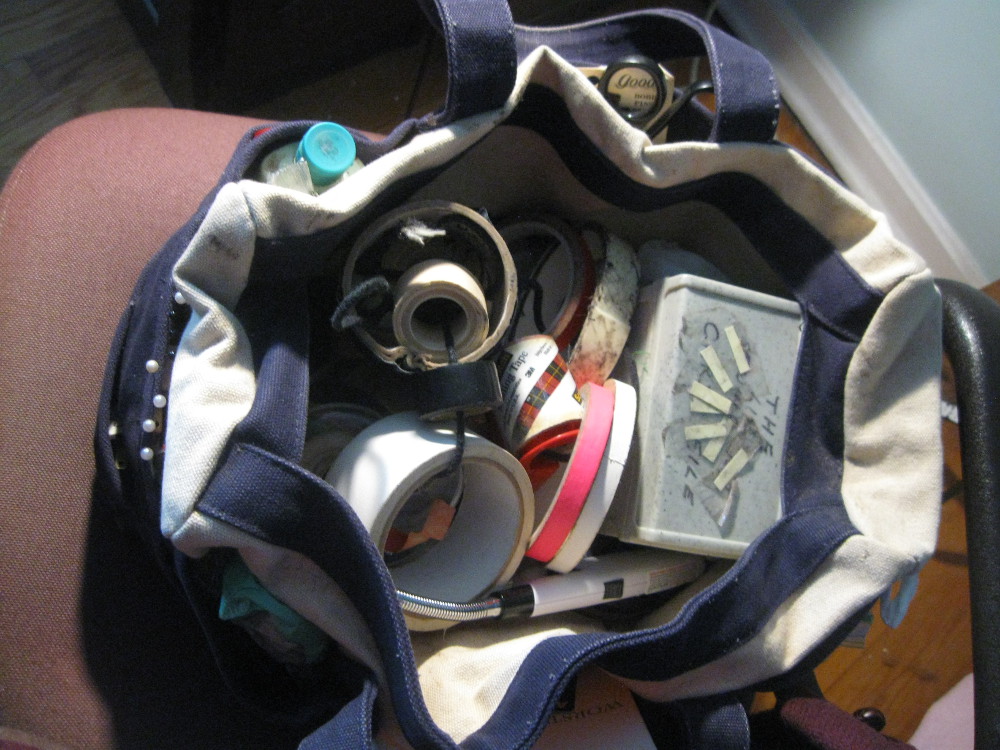
Here’s my hard-working wedding kit–with the famous tape right on top!
Sometimes I get to do the funniest things in my job as a wedding planner and coordinator. You never know what the day is going to throw at you or what you will need to solve a problem. That’s why I always have a wide variety of tools and supplies at hand on a wedding day.
At one wedding recently, the bride’s beautiful white dress developed a problem. The wedding party had just returned from taking photos after the ceremony, and they were lining up for introductions into the reception. That was when the bride told me that her dress wasn’t bustling properly and she was afraid she would trip on it.
I took a quick look at the back of her dress, and it was about as bad as anyone could have imagined. The loop that went over the button to create the bustle had torn right out of the very delicate, sheer organza fabric of her overdress and train. There was a definite hole there, and the train was hanging down asymmetrically–and was definitely likely to trip her up if it wasn’t fixed.
Now, I have just enough experience working with fabric to know that if you try to put a needle and thread through a hole in organza, you are just going to end up shredding the fabric further. There is really no point in trying to sew it back together if you can’t patch it first–and we were on too tight a schedule for that. But if you can’t sew it, what can you do??
I took three steps over to my emergency kit and picked up a roll of white fabric tape (known among stage managers as spike tape for its theatrical uses) and walked back to the bride and her torn dress. One piece of half-inch wide tape went through the thread loop and back down into the hole in the dress. A second piece of tape wrapped around the first piece and around the fabric to hold it in place. The thread loop went back over the button and–poof!–the dress was back in one piece.
If you looked really closely, you could see the repair, but I could see that it was good enough for presentation purposes. And, as I said to the bride, if anyone was looking anywhere but at her beautiful, smiling face, they were looking in the wrong place.
Later, the bride’s mother borrowed a needle and thread from me (because, of course, I have those in my kit, as well) to try to make a more formal repair. But she just ended up confirming my conclusion that repairing organza with a needle is pretty much a lost cause without special skills and/or equipment.
I have to say, I felt pretty triumphant at having such a quick fix close to hand. It’s nice to save the day from time to time!
Oct 8, 2018 | Day-of Coordinating
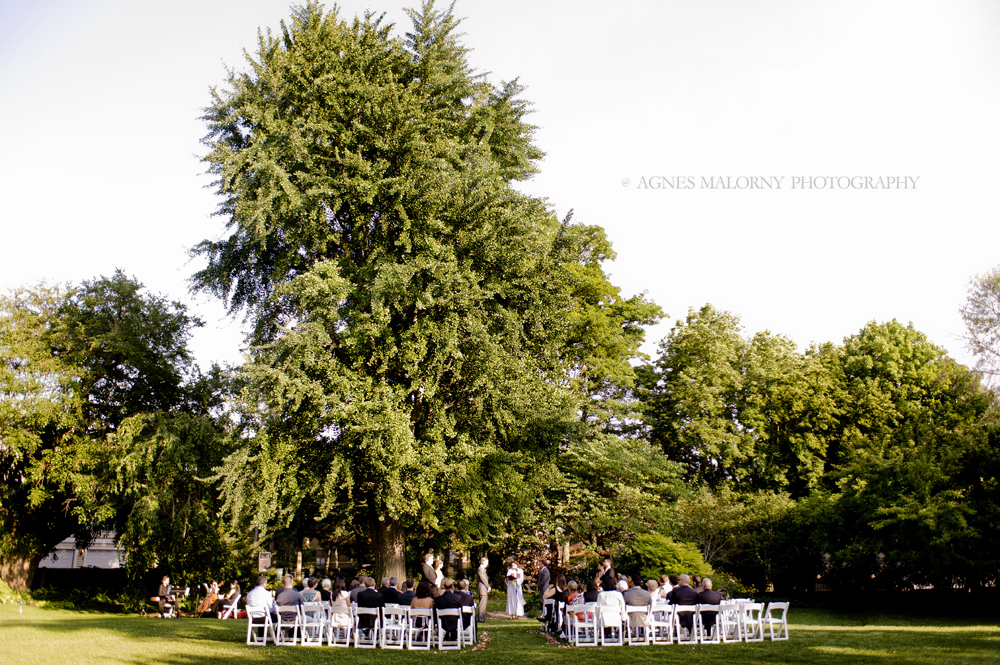
It all looks so effortless, doesn’t it? I enjoy creating that illusion! (Photo by Agnes Malorny Photography.)
There is a lot of misconception in the world about what wedding planners and coordinators do. I think part of the reason people just don’t know what I do is that I try very hard to stay under the radar. If I can solve a problem without anyone knowing about it, I am thrilled. And sometimes I can make things just a little bit better, so I do that invisibly, too. But that means that few people understand the value of hiring me. So, in the interests of tooting my own horn for a few minutes, here are a few things I have done (invisibly, of course!) at weddings just this year so far.
I located a lighter to be used in the wedding ceremony when the couple had not arranged for one.
I worked with the musician on how the music would work for the wedding processional, since the couple had not communicated their wishes to either of us.
After the caterers had set up the reception hall, I counted all the place settings and found the table with an error–and got it fixed before guests had to discover it.
Later, I got a place setting added to a table for an unexpected guest. I even made it happen before the guests arrived at their tables.
Those two things were possible because I had spent a good bit of time before the wedding re-ordering the table lists so that they would be useful for those purposes.
I located the photographers before toasts started, as they thought they had time to take a break right then.
I asked the caterer to reduce the noise they were making during the very quiet song for the couple’s first dance.
At the end of the night, I went around and took down all the directional signs that had been put up for the arriving guests.
I alerted the bus and limo companies to the presence of a street fair near the ceremony venue and gave them directions on where they could wait for their passengers.
I got the temperature of the reception room adjusted when it became clear that the guests were very uncomfortable.
I gave a DJ all of the information he needed about the reception that somehow had not filtered to him from the company hired by the couple.
I packed up desserts for the bride and groom at the end of the reception and gave them to the maid of honor to be taken with them when they left. It was clear to me that they had not had a chance to eat dessert, and they had been excited about it.
I found the correct table for guests when we discovered that the seating chart had an error.
For a reception in a tent in a park, I managed to get the generator started (after 3 or 4 calls to the rental company).
I also arranged for another delivery of ice when the bartenders let me know that we had nearly run out halfway through cocktail hour.
I coached a talented but very green DJ in the art of making wedding reception announcements.
The short version is this: I made sure that all elements were in place for the ceremony; did everything necessary to ensure that the guests were happy; and did what was needed to make sure the couple was happy, as well. And sometimes I wonder why I never sit down when I’m working at a wedding!
Oct 1, 2018 | Non-Traditional Weddings
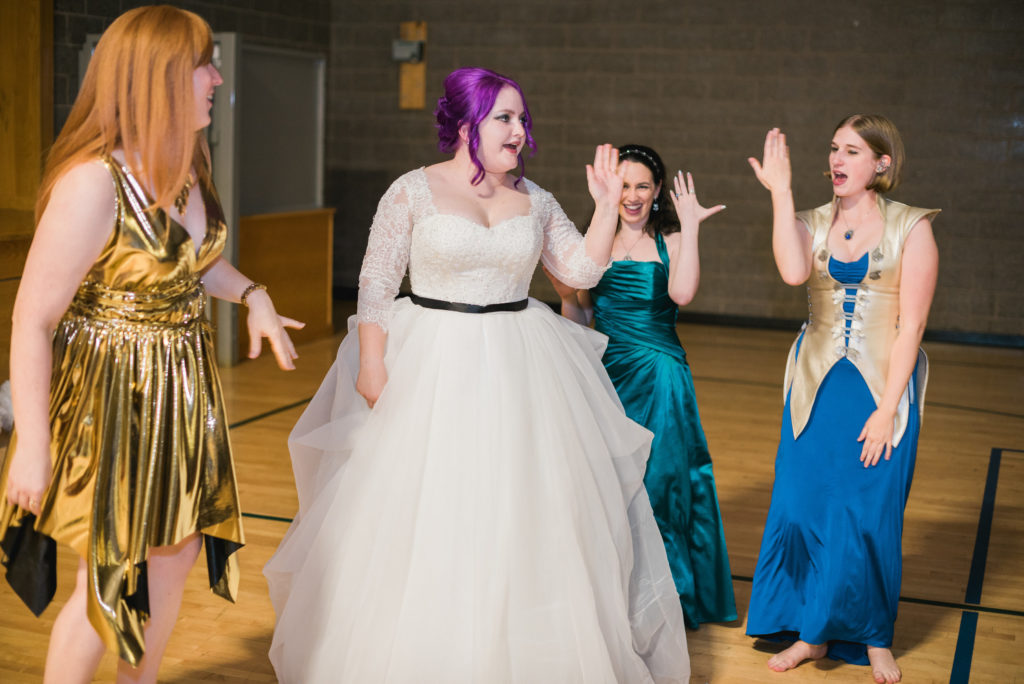
Sometimes you have to do something a little different at your wedding. Photo by Danielle Heinson.
Last week I wrote about the importance of having the wedding you want and how it can keep you from putting unreasonable pressure on yourself. But there’s another side to the question: How can you convince your families that your choices are right for you? Sometimes when you break with tradition, it’s hard to explain it to your family. And–let’s be real–sometimes it’s not worth it to break tradition if it’s going to make your family unhappy. Only you can decide what’s more important.
If you do decide to have a wedding that your family may not approve of easily, you’ll probably have to explain why you are doing what you are doing. In case you’re in this situation, I’d like to offer a few ideas for ways to present your thoughts in a persuasive manner.
If you’re inviting your family to your wedding, it’s probably because you love them. So let them know that even if you are doing things differently, you still love them and still value their opinions–even if you plan to ignore them entirely. But if you’re getting married, it’s because you are an adult and–as an adult–you get to make your own choices about your life, including your wedding.
You can also point out that your wedding is about you and the person you are marrying. Yes, family is very important, but the central focus of the occasion just happens to be you. You and your future spouse have to agree on what kind of wedding you want and how to accomplish that. I think that this important point is often overlooked: Planning your wedding with your future spouse is the first big test of your marriage. Wedding planning is, in some ways, a trial run for how you will make all the big decisions of your life together. You’re creating a new family unit, and sometimes that means pulling away from your families of origin just enough to make a new life for yourselves.
There is, of course, always the issue of money. If one family or both is paying for the wedding and reception, that changes the dynamics. The person writing the checks always has the power to influence the wedding. So, that is something to consider when you begin your planning. If you don’t think your families will approve, do you want to give them a monetary veto? If you don’t have a choice, you may have to give up some autonomy.
Your wedding is also a reflection of who you are as a couple. Chances are, your families will always have some input into it because you aren’t completely separate from your family. But when you are going to do something they never thought of, be prepared to stand your ground. I hope you’ll have some good arguments now.






Recent Comments